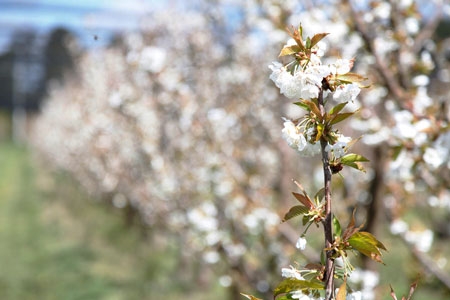Irregularity in cropping is a major economic constraint in many fruit tree orchards. Understanding the mechanisms involved in flowering and fruit set can help orchardists to manage crop loads, resulting in improved yields, fruit quality and returns.
Flower initiation and bud quality
Apples, pears and cherries flower and bear fruit on spurs, short shoots and one-year-old wood, while almonds, peaches and nectarines flower laterally on one-year-old wood. Apricot and plum flower on both one-year-old wood and spurs.
Flower initiation occurs in the spring–summer of the season before flowering. Buds on spurs and short terminal shoots begin initiation 3–6 weeks after bloom in the preceding season, while axillary buds on extension (first year) wood are formed later in the season, usually as shoot growth slows in mid–late summer.
Once flower buds have been initiated, the quality of the developing buds will be reduced by anything that lowers the amount of assimilates produced through photosynthesis, or that diverts these assimilates away from the buds.
Late-initiated flowers often develop only partially and are usually poor quality.
Factors that can lead to reduced assimilates available to the developing buds, thus reducing their quality, include:
• excessive vegetative growth
• lack of light or shaded buds
• poor leaf quality through inadequate nutrition, irrigation or disease/insect attack
• heavy crop load
• high temperatures during the bud development phase causing trees to shut down.
Biennial bearing
Common in many fruit tree species, biennial bearing is the production of a heavy crop one year followed by a light crop the next year.
In pome and stone fruit, biennial bearing is due to lack of floral initiation in the on-year, which leads to poor return bloom the following year.
The seeds in the developing fruit produce auxins that inhibit flower initiation, thus the heavier the crop load during the flower initiation period, the fewer flowers are initiated.
Biennial bearing can also be induced by climatic conditions, stress or orchard management practices.
In apples, some cultivars are less prone to biennial bearing than others. These regular bearers have a high incidence of natural spur extinction.
Fruit set
In fruit trees, flowers differ in their potential to set and retain fruits. This is described as flower quality, and there is a correlation between flower size and eventual fruit size.
Flower quality is commonly estimated by measuring the effective pollination period (EPP).
High quality flowers have an EPP of 4–5 days, while an EPP of one day is classed as poor quality; these flowers set fruit only when pollinated on the day of opening.
The time window for effective pollination and fruit set is much smaller for poor quality flowers compared with high quality flowers, so the aim is to encourage high quality flower production on spurs and short terminal shoots.
Why is early crop load management so important?
The natural fruit drop observed in fruit trees, particularly apples, in early summer is insufficient to achieve optimum crop loads, fruit size and quality, or to prevent biennial bearing.
(cont next issue)
Download the Orchard plant protection guide
See this article in Tree Fruit June 2020






















